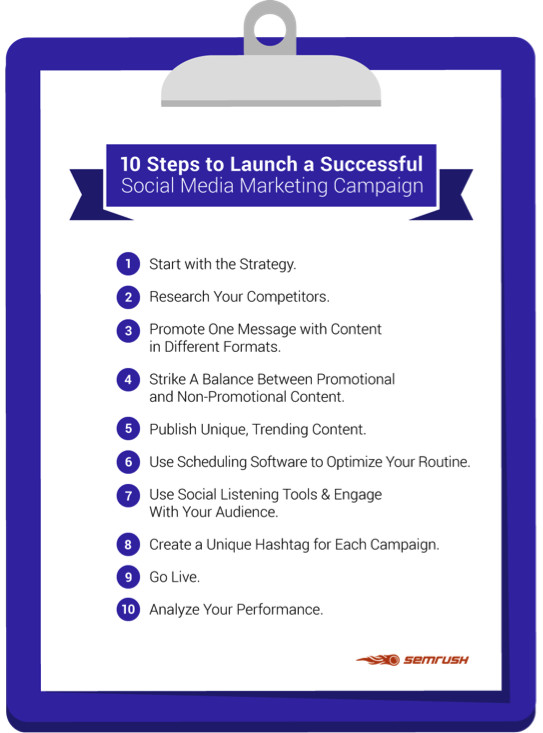It's a common mistake for brands and other businesses to think that social media marketing is going to be easy. There are 14-year-olds on YouTube going viral, we've all thought at some point, so how hard can it really be?
However, social media marketing is more difficult than the existence of kid YouTube stars would lead us to believe. It's not enough to let one great post carry your marketing efforts; instead, you need to be creating and executing entire social media marketing campaigns.
Those campaigns should be strategically designed and created to help you connect with new users, build on-platform relationships, and drive long-term sales.
Although great campaigns take time to create, there are 10 easy steps anyone can follow to produce and launch successful social media campaigns.
1. Research Your Competitors
Researching your competition is a crucial step that a lot of marketers forget in social media marketing, but you don't want to miss this one. It can tell you what's working for your competition. You can then use that valuable insight to inform and improve your own campaigns.
You can, for example, see how the competition covers certain types of topics and what types of content they create. Do they share tutorials or do a lot of Q&As? What posts get the most results? You can also see what times they post, how regularly they're uploading content, and even what tone they're using. Are they selling aggressively or giving more of a subtle nudge?
Uncovering your competitors' social media strategies will allow you to create an even stronger one for your brand, giving you the edge. You can do your research manually, or you can use competitor research tools to compile the data for you.
2. Craft Your Strategy
Before you do anything else, create a solid strategy for your campaigns. Strategy can become complex, but start by breaking it down to the basics.
- First, choose your goal for the campaign. For example, do you want to build an online community, drive more leads to your site, or help promote your blog?
- Next, choose which metrics you'll monitor. Say you want to drive leads to your site; then you might track the number of users contacting you directly or clicking links that are promoting lead magnets.
- Then, craft your messaging and content around the goal in a way that your audience will likely find appealing.
3. Promote One Message With Different Forms of Content
You should have finalized the messaging you want to use in the previous step. Now, in this stage, you'll use different formats to deliver that message, such as infographics, videos, and blog posts, to see what works best.
You can, for example, promote one product with each of these different media types. See what your audience responds to, and keep using diverse formats while you favor those that come out on top. Doing so will keep your channels interesting and your users engaged.
4. Strike A Balance Between Promotional and Non-Promotional Content
That balance is particularly important because of Facebook's new algorithm. If you share only promotional content on social media, people will become uninterested and stop following you. If, however, you share only nonpromotional content on social media, you won't get the kind of results you're hoping for.
So add content to your feed from external sources (content not written by you). For example, find a reputable media source in your industry and repost its top-performing content. That way, your audiences get to see content they might otherwise have missed, and you can build relationships with fellow experts in your industry, too.
5. Publish Unique, Trending Content
This one sounds a bit like an oxymoron (how can content be both trending and unique?), but it's a great strategy to use. Find trending topics or strategies and put your own unique spin on them. If many marketers are writing about how Facebook Zero is going to damage reach, for example, you should be the one who writes about how it will help businesses that make the effort to better connect with their clients.
You, your business, and your product are unique, so don't create cookie-cutter content.
6. Use Scheduling Software to Optimize Your Routine
Trying to create social posts on the fly isn't going to cut it. Instead, optimize your campaigns and your routine by using scheduling software to streamline the process.
You can create a social media calendar in advance, scheduling posts to be published at specific times and dates. This approach significantly reduces the amount of time you'll spend bouncing around on different platforms to upload content, giving you more time to focus on creating great content and engaging with users.
7. Use Social Listening Tools and Engage With Your Audience
Social listening tools are exceptionally powerful. They allow you to see what people are saying about your brand, which may be very different from what they're saying to your brand.
Use social listening tools to monitor the impact of your campaigns and see what people are talking about. You should also specifically check what questions people have about your product, brand, and industry; such questions offer valuable ideas for content.
8. Create a Unique Hashtag for Each Campaign
Hashtags are powerful entities on Instagram and Twitter. They can help drive engagement, and just as important, they can help you track the results of your campaigns.
By creating a unique, branded hashtag for your brand and specific campaigns, you can more easily track engagement and user-generated content even if users don't remember to tag your brand directly in their posts.
Branded hashtags shouldn't replace the more common hashtags that your audience is using. To maximize reach and trackability, use both kinds in each post.
9. Go Live
Livestreaming is a big trend in social media, and if you aren't taking advantage of it, you're missing a prime opportunity. Go live on Facebook or Instagram on topics related to your social campaigns. To increase engagement, host Q&A sessions and answer customer questions asked either beforehand or in the live comments.
The best part? Once the broadcast is over, you can save it and share it as a regular video to your platforms, giving you native video content.
10. Analyze Your Performance
Just because your campaigns may be underway or over doesn't mean the work is done. Regularly analyze the success of your campaign as it progresses, and evaluate it closely once it's over. You can get valuable insight into what worked well and what didn't.
That analysis also gives you the chance to identify the top content from the campaign. You can then reschedule or repurpose it to run again soon, increasing your results and keeping the momentum going.





